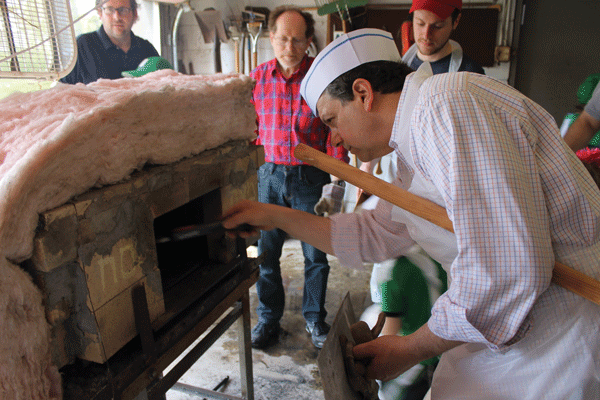For St. Louis family, homemade matzah is a labor of love
Published April 20, 2016
The flames were burning brightly as more than a dozen Jewish males surrounded an oven. They were baking matzah and had only 18 minutes before the grain would ferment and no longer be kosher for Passover.
The makeshift oven was comprised of firebricks, mortar and pink insulation.
This was not in ancient times, but on Sunday, in the garage of a house across from the Ruth Park Golf Course in University City.
ADVERTISEMENT
For the last decade, Dr. Ethan Schuman has baked matzah at his home. He is only a short drive from grocery stores filled with boxes of the Manischewitz variety.
But for Schuman, convenience appears to be secondary. To bake matzah, Schuman said, is a mitzvah.
“Jews have been doing this since time immemorial, baking it by hand in small communities,” said Schuman, who is a dentist and serves as the hazzan at Nusach Hari B’nai Zion in Olivette.
For Schuman, getting closer to a Jewish tradition is worth the hassle of building an oven and assembling a team of helpers each year.
“It’s part of Jewish culture, and I want to continue it,” he said.
On Sunday, the garage door was open and people constantly filtered in and out to help and see the process unfold. There were neighbors, friends and clergy such as Rabbi Moshe Shulman of Young Israel of St. Louis and Rabbi Shaya Mintz of the St. Louis Kollel to oversee the project.
ADVERTISEMENT
Since starting, Schuman has not been able to do the baking each year because he has not been able to round up enough people.
“Everyone wants to see how it can be done, but few people want to put the time in and say, ‘We’re doing it. We’ll stick with you.’ ” Schuman said.
One person stood near the edge of the garage turning a crank — similar to a larger version of one on a pencil sharpener — to ventilate the oven, which Schuman said he had built based on a blacksmith forge design. For kosher purposes, the oven needed to be at least 600 degrees, Schuman said, but he had found through trial and error that the ideal temperature is 900.
That way, “the minute that matzah” is placed in the oven, “it’s almost baked.”
Speed is important because Schuman and his team were operating under strict time constraints. From the moment someone mixes the flour and water, the clock starts: 18 minutes. Jews eat matzah at Passover because when the Israelites fled Egypt, they did not have enough time to allow the bread to rise, and the cracker-like food became a symbol of faith.
Once the oven had reached the proper temperature, Mintz assigned jobs to each person. One person measured the flour, a special variety ordered from New York and New Jersey that had “been guarded by rabbis from the moment it was harvested,” Schuman said. His crew ordered eight pounds.
Another worker added water and started mixing. Then someone rolled the dough. Unlike the store-bought variety, these matzah were circular in shape. The next person in the assembly line used a metal tool to score it, so that it would cook all the way through.
Then Schuman lifted the dough with a tray and placed it in the oven, the same way someone would with pizza.
All the while, the workers regularly called out “l’shem matzos mitzvah,” which means, “for the sake of making the matzah that we use for the commandment,” Rabbi Shulman said.
After a minute or two, Schuman removed the matzah from the oven and placed them in boxes. Some were abstract shapes, others a little burnt. As fellow University City resident Michael Oberlander put it, “we’re not professionals.”
“So it’s not consistently good, but some of them are excellent,” said Oberlander, who belongs to NHBZ and Bais Abraham, but also wore a Cubs hat, which the group said was still kosher. “I like the burnt ones, so it’s good.”
The crew did several cycles. Before starting a new shift, they had to thoroughly clean the space, to ensure there was no leftover dough, which would then be considered “chametz,” leavened food, Mintz said. The workers cleaned the dough from their fingernails under a spigot and used a power sander to remove anything stuck to the rolling pins. The matzah baking blurred the lines between shop and cooking classes.
Once each person had put on a fresh apron, the next cycle started. The preparations, baking and cleanup took about four hours, Schuman said. The crew also used the eight pounds of flour, but still they did not make nearly enough to provide each person, or even just Schuman, with matzah for all eight days of Passover. But that’s not the point, Schuman said.
“The goal is not to produce enough matzah for the whole Passover nor is it to have all the matzah for one seder. The goal is to have a piece a matzah that you made or saw being made,” said Schuman. Otherwise, “it remains a mystery to people. How does this happen? What goes into it? What’s involved with making this?”
















